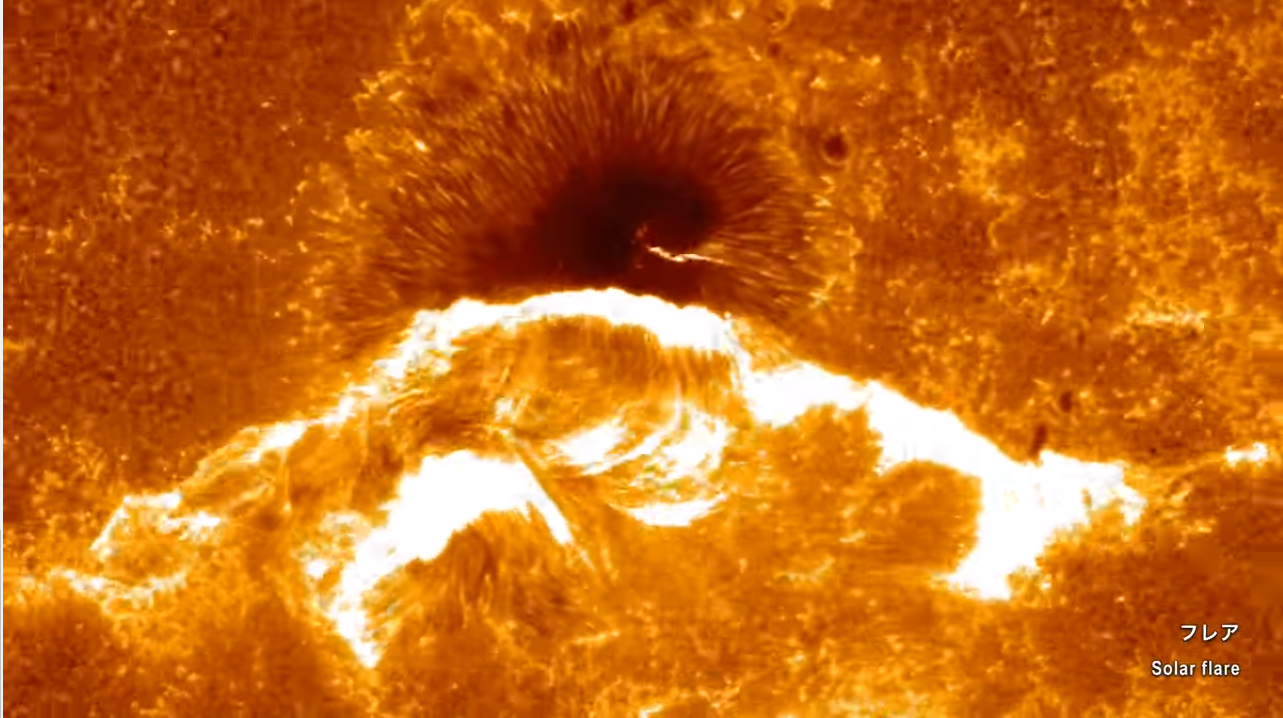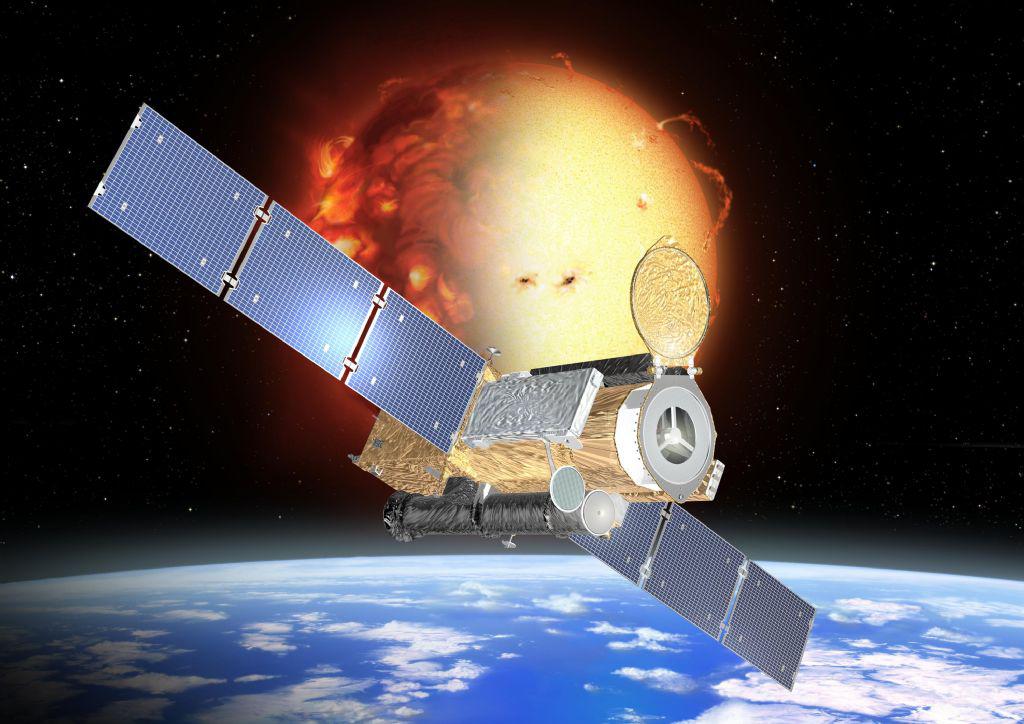Japan's Hinode sun-observing satellite has delivered spectacular imagery and invaluable measurements of the sun since it launched into space 10 years ago on Sept. 23, 2006.
Hinode is part of an international mission led by the Japan Aerospace Exploration Agency (JAXA) in collaboration with NASA and other partners. Over the course of a decade, the spacecraft has provided remarkable views of violent solar flares, eruptions, transits across the sun and much more. To celebrate Hinode's 10-year anniversary, JAXA and NASA unveiled this amazing video showcasing the probe's launch and most spectacular views of our closest star.
The Hinode satellite — named after the Japanese word for "sunrise" — travels in a sun-synchronous orbit around Earth less than 400 miles (640 kilometers) above the planet's surface. It was launched into orbit to get an up-close view of the sun and measure its magnetic field. To accomplish this feat, the satellite is equipped with three scientific instruments: the Solar Optical Telescope, X-ray Telescope and Extreme Ultraviolet Imaging Spectrometer. [Solar Eclipse Photos: The View From Space]
Using these tools, the Hinode probe is able to peer deep into the sun's innermost atmosphere and study the generation, transport and dissipation of magnetic energy from the lower solar atmosphere, called the photosphere, to the upper solar atmosphere (the corona), NASA officials said on the Hinode mission page.

Scientists use Hinode's measurements to learn more about how energy that is stored in the sun's magnetic field is released in the form of violent solar fares or eruptions.
During its tenure in space, the Hinode satellite has also watched as the moon passed in front of the sun for what is known as a solar eclipse. Since the satellite constantly orbits Earth from pole to pole, it provides a unique view of that solar event.

In 2011, Hinode spotted two huge holes, or gaps, in the sun's magnetic field. Scientists call the sun holes "coronal holes" and have found that they act as gateways for solar material and gas to escape out into space.
With 10 years under its belt, the Hinode satellite continually reveals new solar secrets and spectacular imagery of Earth's closest star.
Quelle: SC
-
Update: 22.09.2016
.
Since its launch on Sept. 22, 2006, Hinode, a joint mission of the Japan Aerospace Exploration Agency (JAXA) and NASA, has been watching the sun nearly non-stop, providing valuable insight into our star – and others throughout the universe.
“The sun is terrifying and gorgeous, and it’s also the best physics laboratory in our solar system,” said Sabrina Savage, project scientist for Hinode at NASA's Marshall Space Flight Center in Huntsville, Alabama. “In the past 10 years, Hinode has focused on understanding our sun as a variable star.”
Hinode has captured everything from solar explosions to the delicate motion of solar spicules, allowing scientists to study these phenomena in great detail. As most of Hinode’s instruments are still in good working order, the team behind Hinode hopes to delve even deeper into our nearest star.
“We recently adjusted mission operations to track a single target for several days, instead of jumping around among active regions,” said Savage. “This new paradigm will allow us to get a more complete picture of active region evolution.”
To celebrate Hinode’s first 10 years in orbit, here are 10 highlights from Hinode’s scientific accomplishments of the past decade.
This image of Venus was taken during the Venus transit of June 5, 2012, by Hinode’s Solar Optical Telescope. In this image, Venus is just beginning its journey across the face of the sun. Its atmosphere is visible as a thin, glowing border on the upper left of the planet. Scientists used images from the Venus transit, taken by Hinode and other sun-watching satellites, to study the atmosphere of Venus.
These images of the moon eclipsing the sun on May 12, 2012, coincided with a simultaneous annular eclipse visible from parts of the western United States and Southeast Asia. An annular eclipse happens when the moon passes directly in front of the sun at a point in its orbit when it is relatively far from Earth. This extra distance makes the moon appear smaller than the sun in the sky, so it doesn’t block the entire face of the sun, instead leaving a thin glowing band – often known as a ring of fire – around its edge.
Hinode’s Solar Optical Telescope imaged the sun’s chromosphere – a thin layer between the sun’s surface and atmosphere – on Jan. 12, 2007. This image showcases the filament structure of solar material that is pulled and stretched by the sun’s complex and ever-changing magnetic forces.
This footage from Hinode’s X-ray Telescope is a composite of nearly two months of images, from Aug. 17, 2013, to Oct. 4, 2013. The bright spots near the center of the disk are active regions, areas of concentrated magnetic field that are prone to eruptions like solar flares and coronal mass ejections. These images were captured near the maximum activity phase of the sun’s 11-year cycle, a period during which active regions are concentrated near the sun’s equator.
Hinode captured this image of Comet Lovejoy – seen here as an orange streak in the lower left of the frame – with its Solar Optical Telescope on Dec. 16, 2011. Comet Lovejoy is a large member of the Kreutz family of comets, a group of comets that often pass extremely close to the sun. Comet Lovejoy is rare in that it survived its trip around the sun, emerging intact on the other side.
Hinode caught this view of a solar explosion on Aug.1, 2014. This explosion was set off by unstable magnetic fields on the sun’s surface. The footage was captured by Hinode’s X-ray Telescope. Though X-rays are typically invisible to our eyes, they are colorized here in orange for easy viewing.
Hinode’s Solar Optical Telescope took this close-up of a solar filament on Oct. 19, 2013. Filaments are huge ribbons of relatively cool material that thread through the sun’s atmosphere, called the corona. Scientists used this image and others from Hinode to learn more about how solar material is heated in the corona.
What happens to a sunspot during a solar flare? Hinode helped answer that question with this view of a flare taken by its Solar Optical Telescope on Dec. 13, 2006, just a few months after launch. The bright threads of solar materials visible over the sunspots helped scientists deduce how sunspots and solar flares are linked.
Hinode’s Solar Optical Telescope captured this footage of the sun’s limb. The thread-like structures – which somewhat resemble grass waving in the wind – are spicules, giant plumes of gas that transfer energy through the sun’s various regions.
This close-up from Hinode’s Solar Optical Telescope shows convection cells on the surface of the sun. Convection is one way that the sun transports energy from its depths up to the surface, where it’s emitted as light and heat.
Quelle: NASA










